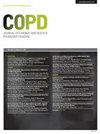Real-World Disease Burden and Healthcare Resource Utilization Among Patients with COPD and Asthma Using Triple Therapy (FF/UMEC/VI) in the United States
IF 3.1
3区 医学
Q1 Medicine
International Journal of Chronic Obstructive Pulmonary Disease
Pub Date : 2024-01-25
DOI:10.2147/copd.s423993
引用次数: 0
Abstract
Purpose: Chronic obstructive pulmonary disease (COPD) and asthma are associated with chronic inflammation of the respiratory tract; despite some overlap of symptoms, they are considered separate disorders. Triple therapy is recommended for patients with COPD and asthma whose symptoms remain uncontrolled despite dual therapy. There are limited real-world studies evaluating outcomes among patients with COPD and asthma who are receiving inhaled triple therapy. This United States (US)-based real-world study aimed to evaluate clinical and economic outcomes among patients with COPD and asthma receiving single-inhaler triple therapy (fluticasone furoate/umeclidinium/vilanterol [FF/UMEC/VI]).Patients and Methods: Retrospective pre-post study using claims data from the Optum Clinformatics® database. Patients with COPD and asthma were indexed on the first date of FF/UMEC/VI prescription (1 October 2017– 31 March 2019). Each patient acted as their own control. Patients were required to have continuous health plan enrollment for 12 months prior to (pre-treatment) and following (post-treatment) index. Exacerbations, all-cause and COPD-related healthcare resource utilization, and costs were compared before and after FF/UMEC/VI initiation.
Results: Overall, 2743 patients were included (mean age: 71 years; 64% female). Cardiovascular disease was the most prevalent comorbidity during both the pre- and post-treatment periods (90% for both periods). There was a lower proportion of patients with ≥ 1 COPD exacerbation or ≥ 1 asthma exacerbation post-treatment versus pre-treatment (51% vs 57%, p< 0.0001, and 22% vs 32%, p< 0.0001, respectively). Fewer patients had ≥ 1 all-cause office visit post-treatment versus pre-treatment (99.3% vs 99.7%, p=0.0329); more patients had ≥ 1 COPD-related office visit post-treatment versus pre-treatment (89.6% vs 87.5%, p=0.0035). Total all-cause healthcare costs were significantly higher post-treatment versus pre-treatment (&dollar72,809 vs &dollar63,734, p< 0.0001). The driver of increased costs appeared to be primarily non-COPD-related (COPD-related costs: post-treatment &dollar27,779 vs pre-treatment &dollar25,081, p=0.0062).
Conclusion: FF/UMEC/VI reduced exacerbations among patients with COPD and asthma in a real-world setting in the US.
Plain Language Summary: Chronic obstructive pulmonary disease (COPD) and asthma are different respiratory conditions that have similar symptoms. Patients can be diagnosed with both conditions at the same time. A flare-up of COPD or asthma symptoms can lead to a lung attack, which can result in hospitalization and a considerable decline in patient health as well as being associated with high healthcare resource use and costs.
An inhaler with three different medicines (fluticasone furoate, umeclidinium, and vilanterol; shortened to FF/UMEC/VI) can be prescribed for patients with COPD or asthma. This study was done to assess how FF/UMEC/VI (taken using a single inhaler) affected lung attacks as well as healthcare resource use and costs among patients who have been diagnosed with both COPD and asthma.
This study found that fewer patients experienced a lung attack in the first 12 months after starting FF/UMEC/VI compared with the 12 months before starting FF/UMEC/VI. A lower proportion of patients had ≥ 1 medical office visit, ≥ 1 hospital admission, or ≥ 1 emergency room visit after starting FF/UMEC/VI compared with before FF/UMEC/VI. Many patients in this study had other medical conditions such as heart and kidney disease as well as their asthma and COPD. Although total healthcare costs were higher for patients after they had started FF/UMEC/VI compared with before, this appeared to be mainly due to patients’ other medical conditions, besides from COPD.
FF/UMEC/VI may be able to reduce future symptom flare-ups and lung attacks in patients who have been diagnosed with both COPD and asthma.
Keywords: asthma, chronic obstructive pulmonary disease, exacerbation, HCRU, real-world, triple therapy
美国使用三联疗法(FF/UMEC/VI)的慢性阻塞性肺病和哮喘患者的实际疾病负担和医疗资源利用情况
目的:慢性阻塞性肺疾病(COPD)和哮喘与呼吸道的慢性炎症有关;尽管症状有些重叠,但它们被认为是不同的疾病。慢性阻塞性肺病(COPD)和哮喘患者在接受双重治疗后症状仍未得到控制,建议采用三联疗法。对接受吸入三联疗法的慢性阻塞性肺病和哮喘患者的疗效进行评估的真实世界研究非常有限。这项基于美国的真实世界研究旨在评估接受单吸入剂三联疗法(糠酸氟替卡松/优甲乐/维兰特罗 [FF/UMEC/VI])的慢性阻塞性肺病和哮喘患者的临床和经济疗效:使用 Optum Clinformatics® 数据库中的理赔数据进行事后回顾性研究。慢性阻塞性肺病和哮喘患者在首次开具 FF/UMEC/VI 处方的日期(2017 年 10 月 1 日至 2019 年 3 月 31 日)进行索引。每位患者作为自己的对照组。要求患者在索引前(治疗前)和索引后(治疗后)的 12 个月内连续加入医疗保险。对开始使用 FF/UMEC/VI 前后的病情加重、全因和慢性阻塞性肺疾病相关的医疗资源利用率以及成本进行比较:共纳入 2743 名患者(平均年龄:71 岁;64% 为女性)。在治疗前后两个阶段,心血管疾病都是最常见的合并症(两个阶段均为 90%)。与治疗前相比,治疗后慢性阻塞性肺疾病≥1 次加重或哮喘≥1 次加重的患者比例较低(分别为 51% vs 57%,p< 0.0001 和 22% vs 32%,p< 0.0001)。治疗后与治疗前相比,全因就诊次数≥1 次的患者人数较少(99.3% vs 99.7%,p=0.0329);治疗后与治疗前相比,全因就诊次数≥1 次的患者人数较多(89.6% vs 87.5%,p=0.0035)。治疗后与治疗前相比,全因医疗总费用明显增加(72,809 美元 vs 63,734美元,p< 0.0001)。费用增加的驱动因素似乎主要与慢性阻塞性肺病无关(慢性阻塞性肺病相关费用:治疗后 27,779 美元 vs 治疗前 25,081 美元,p=0.0062):在美国的实际环境中,FF/UMEC/VI 减少了慢性阻塞性肺病和哮喘患者的病情恶化。平实的语言摘要:慢性阻塞性肺病(COPD)和哮喘是症状相似的不同呼吸系统疾病。患者可同时被诊断出患有这两种疾病。慢性阻塞性肺病(COPD)或哮喘症状的发作可导致肺部疾病发作,从而导致患者住院治疗、健康状况大幅下降,并与高医疗资源使用率和高成本相关联。可为慢性阻塞性肺病或哮喘患者开具含有三种不同药物(糠酸氟替卡松、乌甲素和维兰特罗,简称 FF/UMEC/VI)的吸入器。这项研究旨在评估 FF/UMEC/VI(使用单个吸入器吸入)对同时被诊断患有慢性阻塞性肺病和哮喘的患者的肺部发作以及医疗资源使用和成本有何影响。与服用 FF/UMEC/VI 前相比,服用 FF/UMEC/VI 后≥1 次就诊、≥1 次入院或≥1 次急诊的患者比例较低。在这项研究中,许多患者除了哮喘和慢性阻塞性肺病外,还患有心脏病、肾病等其他疾病。虽然与开始使用 FF/UMEC/VI 前相比,开始使用 FF/UMEC/VI 后患者的总医疗费用较高,但这似乎主要是由于患者除慢性阻塞性肺病外还患有其他疾病。
本文章由计算机程序翻译,如有差异,请以英文原文为准。
求助全文
约1分钟内获得全文
求助全文
来源期刊

International Journal of Chronic Obstructive Pulmonary Disease
RESPIRATORY SYSTEM-
CiteScore
5.10
自引率
10.70%
发文量
372
审稿时长
16 weeks
期刊介绍:
An international, peer-reviewed journal of therapeutics and pharmacology focusing on concise rapid reporting of clinical studies and reviews in COPD. Special focus will be given to the pathophysiological processes underlying the disease, intervention programs, patient focused education, and self management protocols. This journal is directed at specialists and healthcare professionals
 求助内容:
求助内容: 应助结果提醒方式:
应助结果提醒方式:


